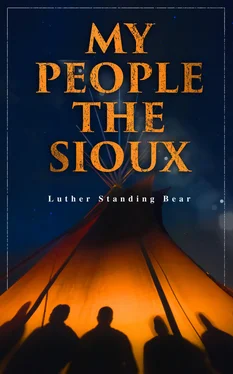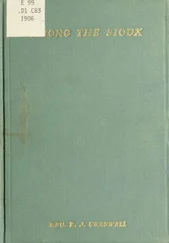Other bags which held the clothing of the family were made and decorated with dyed porcupine quills. These were made round, from tanned buffalo skins. The woman cut out the size she desired, then sewed it with sinew, with buckskin tie-strings attached.
In those days we used to eat the porcupine. Every portion of the body was utilized. The hair was used in the manufacture of the dancing-headdress; the tail was made into a comb; the quills were dyed by the women and used for a variety of purposes in their fancy work.
This porcupine quill-work was quite an art. The pulling of the quills required some time, and one had to be careful that the quills did not get into one’s fingers. The dyeing of these quills was also quite a scientific art.
In decorating a bag, the woman would place several of the dyed quills in her mouth. This dampened them, and she would then flatten them with her finger nails and run them through little holes made with an awl. Several colors would be used in the work, and, when it was finished, the woman had a very pretty design. Several rows of quills were put around the bag. If a fancy bag was desired, a few tassels were added to the sides.
When these round bags were in place on top of the rawhide bags, and the painted skin was hung up behind them, and the beds all made and a fire burning, the tipi looked just as neat as any white man’s house.
When we were all settled for winter, our women fixed up the tipi as comfortably and inviting as possible. Not for Thanksgiving Day, for we were taught to give thanks every day. Not for Christmas or New Year’s, because we knew nothing of these holidays of the white man. It was solely for our own pleasure, and the assurance that we were safe for the long winter months.
The entrance to the Black Hills was through a narrow passage known as ‘Buffalo Gap.’ The wild animals came in through this gap for protection from the icy blasts of winter; and the Sioux likewise went there. There were springs of clear water and plenty of wood. Nature seemed to hold us in her arms. And there we were contented to live in our humble tipis all through the rough weather.
After a time, of course, our tipis would begin to get old and worn. The poles would commence to break off. Then was the time to think of getting new ones. The entire tribe was in the Black Hills, where they could get all the poles they wanted. They used fir pines, as they were the straightest, and could be found in all sizes. The men would chop down as many trees as they needed and haul them to camp one at a time. First, the bark was peeled off, with all the small limbs. When all the trees had been brought to camp, one would be leaned against a standing tree for a brace. A block of wood was fastened to the butcher knife to be used as a draw-shave. Before the Indian had steel knives he used a sharp stone to do this work. As most of the poles were cut to about the required size, it was not very hard work to finish them. The Indian had no boss standing over him, and he took his own time.
After the poles were all finished, they were arranged in conical form to dry out. If one began to get crooked during this drying-out process, it was turned around with the crook on the outside. This served to straighten the pole. It required about three days for the poles to dry and ‘season.’
While the stronger of the men were preparing the poles, the old men also found plenty of work to do. They made the stakes which were to hold the tipi down, and prepared the pins that were to hold the tipi together in front. After they had those finished, they made some other sticks about two feet long, with a hole in one end through which was passed a rawhide thong. These were used in moving camp. All tipi poles had a hole in one end. When it came time to break camp, these small sticks were tied to as many of the tipi poles as a pony could comfortably carry on one side. The rawhide string from the small stick was slipped through the holes in the tipi poles, which kept them from slipping and being lost.
Now that all the poles, sticks, pins, and stakes were prepared for the new tipi, the next and hardest job was to get the skins with which to cover the tipi poles. The entire tribe started to move to northern Nebraska, as they knew this to be a good hunting-ground. Scouts were sent out ahead to locate the buffalo herds. When they returned with the location of a herd, the hunters would prepare to start out on the hunt.
All the relatives now assembled and entered into an agreement that all the skins from the first hunt were to go to the head of the band. If they did not secure enough hides from the first hunt, then the next one was also to go to him. The hunters would kill as many buffalo as possible, and the skins were removed very carefully. As they were to be used for tipi coverings, there must be no holes in them.
As soon as the hides were brought in, the women spread them on the ground and pegged them out while they were yet fresh, with the flesh side up. Three or four women would then commence to remove all superfluous bits of meat from the hide. In this work they used a piece of flint or a sharp stone before steel and iron came into use among them. These ‘fleshers’ were shaped like a crowbar with teeth in the end. The handle was covered with buckskin, with a buckskin string attached to tie up around the wrist, which helped to hold the instrument.
After all the meat was removed from the skin, and it had dried out, it was turned over with the hair on top. Then, with a tool made of elk-horn, they scraped off all the hair. This instrument, clasped in both hands, was used by the women, who worked it toward them. They were very expert in this work.
When the hair had all been scraped off, it showed a layer of skin which was dark. This was also removed, showing another layer of white. This the women took off carefully in little flakes, and it was used in making a very fine soup. The brains and liver of the buffalo were cooked together, after which this mixture was rubbed all over the skin. It was then folded into a square bundle for four or five days. Several of these bundles of skins would be piled on top of each other.
A frame was now built on which to stretch the skin after it was opened. This frame was made of round poles tied together at the four corners with rawhide thongs. When the skin was opened, it was damp. It was fastened to the frame with rawhide rope run through the peg-holes around the edge of the hide. The mixture of brain and liver was now all scraped off, and the skin washed with water until perfectly clean. The women then went all over the skin with a sandstone, which made the hide very soft.
A braided sinew was then tied to a naturally bent tree, and the other end fastened to a stake driven in the ground. This made the sinew taut, like a bowstring. The skin was then taken off the frame and pulled back and forth on this sinew, by the women, until it was very soft. The effect of this was to produce a beautiful white tan.
At that time our women wore dresses with open sleeves, and, when a person stood behind them as they were pulling on the skin, they resembled angels flying, as the big sleeves flapped back and forth.
These skins were now ready to be put away until enough more were finished to make the tipi. While some of the women were busy tanning the skins, others were engaged in cooking, making dried meats, and getting all the sinew on the poles to dry. The sinews were the cords in the animals, and were used by the women in lieu of thread. There was no waste, I can assure you. When a sufficient number of skins for one tipi were finished, that part of the skin which had the holes in was trimmed off and the hides were patched together.
To begin to measure a tipi, two poles were laid on the ground and were squared off. All tipis were made to look as if they were sitting down. When the skins were being sewed together, the women put them down on these poles and made a circular bottom, much the same as the white women make a circular bottom skirt. When enough skins were sewed together to fit in between these two poles, then it was put around the back pole. More skins were then sewed on until it came back to the front pole again. A small extra piece of skin was allowed in the center, at the top of the back. It was to this piece that the rawhide rope was tied to fasten the tipi to the pole. This was the last pole to be lifted in erecting the tipi.
Читать дальше












